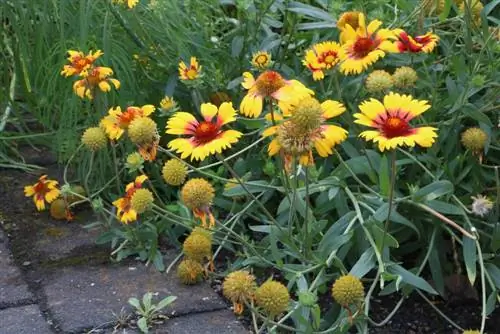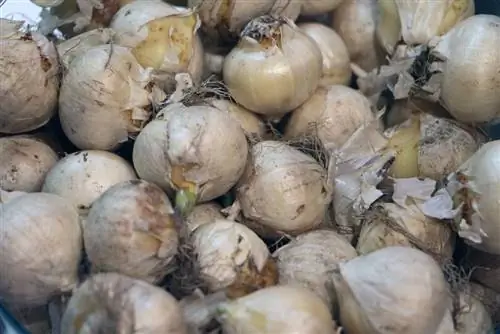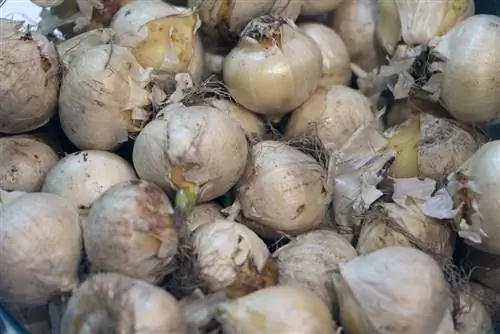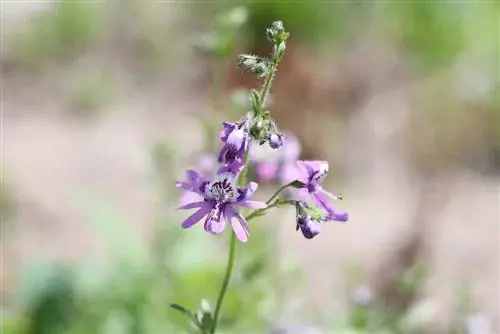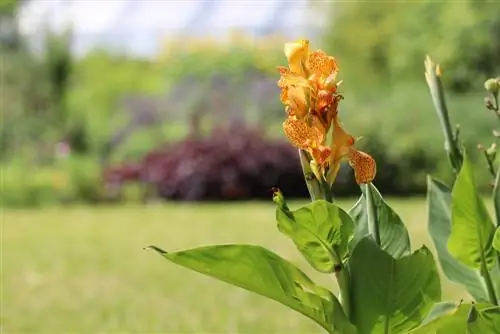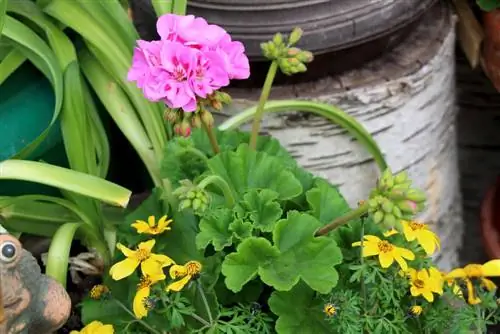- Author admin [email protected].
- Public 2023-12-17 03:39.
- Last modified 2025-06-01 06:48.
The cockade flower is a fascinating perennial plant from the daisy family that impresses with its beautiful play of colors. Yellow, red, orange and brown tones determine the often two-tone flowers, which stretch towards the sun on strong stems all summer long. The beautiful perennial native to North America with a height of 40 cm is a real eye-catcher in the home garden. It forms a dreamlike ensemble in borders, beds and rock gardens together with the red coneflower, girl's eye, lupine and the graceful fine-ray aster. But it is also ideal as a cut flower for a romantic summer bouquet.
Varieties and species
Cockade flowers, which are also known as painter's flowers, are considered real permanent bloomers and are characterized by a very special charm. The many different varieties include:
- the burgundy, which reaches a height of 40 - 50 cm and presents itself with strong red flowers
- the 30 cm yellow goblin, which shows all its flowers from July to October
- the cockade flower Tizzy, which unfolds its red flowers in a sunny location from June to September and
- the grateful Bremen variety as a larger representative among perennial plants with a height of 70 cm, which develops fascinating dark scarlet flowers
Other popular varieties include the 15 cm small, red Büble and the Sunburst variety with its predominantly bright yellow flowers as well as the one- and two-color Lorenziana mixture, which reaches a height of 60 cm and has double flowers.
General care tips
Location and soil
So that the attractive perennial can develop beautiful flowers and thrive splendidly, it should have a:
- maintain a sunny location
- in a nutrient-rich, light, permeable and humus-rich soil
- which is permeable but not too moist
- e.g. sandy loam soils
- Sand is incorporated into heavy soils to prevent rot
Fertilization
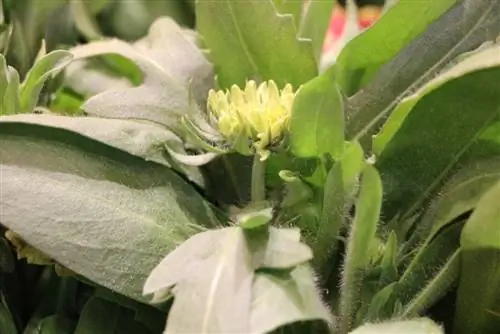
The colorful cockade flowers, like many garden plants, feed on dead animal and plant remains that are decomposed in the soil by earthworms or bacteria. However, since plants generally need more nutrients than the soil can provide, regular fertilization is advisable.
- with a mineral-organic fertilizer
- which ideally contains added guano
- recommended quantity: 20 to 30 g/m²
- Liquid perennial fertilizer is added to the irrigation water
- and administered once a week after the first flower shoots
Pouring
The attractive daisy family requires regular but moderate watering and additional watering in very dry conditions.
But they cannot tolerate waterlogging, so the soil must be well drained so that excess water can drain away without problems. If the perennial is planted a little higher, this problem can also be prevented.
Tip:
Watere preferably in the morning and evening and never in full sun!
Care and pruning
The graceful perennial is extremely flowery and produces numerous new flowers if it receives sufficient care. Therefore, wilted inflorescences should be removed immediately. In addition, heavy pruning significantly promotes tillering, causing the plant to adopt a bushy, semi-spherical habit. If the shoots are radically cut back above the ground about 5 - 10 cm after the main flowering, they will develop he althy new growth, depending on the variety and species.
This is how the perennial gets through the winter well
Many varieties of perennial cockade flowers are winter-hardy but not hardy. However, to ensure that they survive the cold season well, some measures should be taken.
- Pruning at the end of September after the flowering period
- so the plant can form a tuft of leaves
- Winter protection by covering with brushwood branches
Tip:
After a while, cockade flowers winter out. Therefore, a division after one or two years is appropriate.
Planting
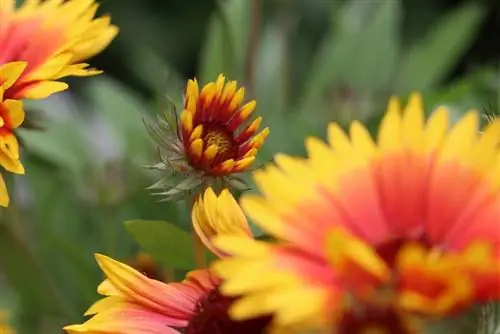
Replanting and dividing the popular perennial is done in spring and is quite simple and uncomplicated. If it is given an ideal location and favorable soil conditions prevail, the cockade flower will grow well and can develop lush flowers in the same year.
Sowing
- End of March to April preferably in potting soil
- germination occurs after 2 weeks at temperatures of 15 - 18 degrees
- after sowing, the young plants are pricked out about 4 - 6 weeks
- and placed in pots
- planting in the bed can be done according to the Ice Saints
- at a distance of 25 - 35 cm
From the end of April, direct sowing outdoors is also possible.
Propagation
Cockade flowers can reproduce independently by self-sowing or by division, which is particularly useful for older plants. All you have to do is remove the plant from the ground, separate the old stock and replant the root cuttings.
Diseases and pests
The beautiful perennials do not require extensive but still some care to protect them from diseases and pests such as aphids, powdery mildew, downy mildew and leafhoppers.
Aphids
- a lye mixture consisting of water and dishwashing liquid
- which is not poured over the plant but into the soil
- Alternatively, a liquid pesticide could also be used
Foam cicadas
These 5 to 10 cm small insects like to attack herbaceous plants and cause an unsightly coating on stems and stems with their so-called cuckoo saliva. If cockade flowers are attacked by the leafhopper, spraying them with a hard jet of water is sufficient. However, it is important to ensure that the larvae are also removed, otherwise cuckoo saliva could form again after a short time.
Powdery and downy mildew
These are fungal diseases that appear in powdery mildew in the form of a flour-like, whitish coating on flowers and stems. In the case of downy mildew, purple, yellow or brown spots form in addition to the whitish coating. Both variants can be treated in the following way:
- Spraying the affected area with chemical or
- silicic acid-containing agents
- A decoction of onions or garlic also helps against downy mildew
- remove affected plant parts immediately
- BUT do not dispose of it in the compost, but in the garbage can to prevent it from spreading!
Interesting facts
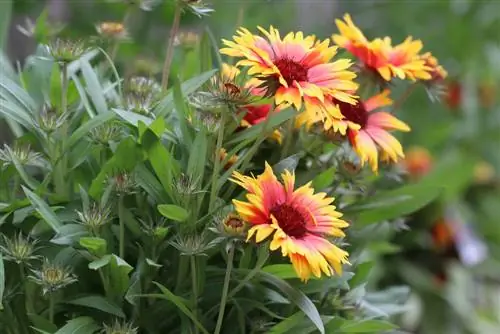
Sowing begins between March and April. Moist sowing soil is used in pots and bowls. Do not cover the seed. Cultivation continues in a germination box at 20-25 degrees Celsius. A lot of light is needed for germination to occur. The soil must be moist, but not wet.
When the seedlings are large enough, they are transplanted into larger pots or bowls. The young plants need to get used to outdoor conditions for around 14 days. After the Ice Saints, they are planted in the garden at a distance of 30 cm. Cockade flowers love heavy, humus- and nutrient-rich soil, preferably mixed with sand. They prefer sunny, warm and protected locations. From June to October, the cockade flower enchants with a sea of flowers. They primarily attract bees and butterflies. If you remove dead flowers regularly, new flowers will continue to form. The plant needs water regularly, but must not be damp. The warmer it is, the better it blooms. In cool, rainy summers the flora usually remains sparse. Fertilization is carried out every 3 weeks.
Larger plants are tied up. After the end of flowering, the perennial is cut back heavily. It should develop its new tuft of leaves before winter. If the cockade flower has spread too much, it should be divided. Even if it is bare on the inside or no longer blooms properly, division makes sense. The best time for this is spring. This can be done easily with a spade. Then place the parts in loose soil enriched with compost. If the dead inflorescences are not removed immediately, the cockade flower sometimes reproduces through self-sowing.
Cockade flowers are not long-lasting. They often don't survive the winter. That's why the plant needs protection from brushwood in the cold season. However, it rots very easily under a layer of leaves and peat.
This perennial is particularly suitable for rock gardens and borders. They can be combined well with brownwort, speedwell, golden rue, Indian nettle, lupine, girl's eye, prairie mallow and sage. Cockade flowers are almost never attacked by snails. However, they are not resistant to aphids, leafhoppers and powdery mildew.
Conclusion
The cockade flower is a perennial that requires little care and is therefore ideal for hobby gardeners. If it is watered and fertilized regularly and the withered stems and leaves are removed, it will thank you with a magnificent abundance of flowers. The winter-hardy perennial is available in many different types and can be propagated in different ways. With its colorful flowers, it enchants many a home garden in beds and borders.

